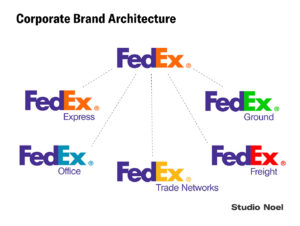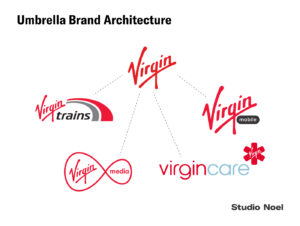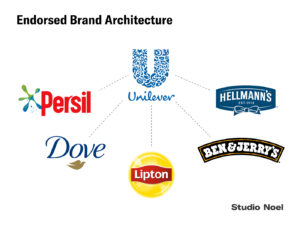Brand architecture: is it just another buzzword for another day, or can it draw in and inspire loyalty from customers and benefit a brand’s piggy bank?
If you look at brand giants such as Apple, P&G, Unilever, or Virgin, brand architecture has played a major part in keeping these brands strong and relevant throughout the years and ensuring there is harmony between the array of products and services they offer their customers.
Of course, the benefits of brand architecture don’t only apply to large and well-established companies. The same benefits can also be enjoyed by smaller businesses who still want to make sure their product is in line with their company ethos, their brand is consistent and recognisable, and there is no discord between how their company and what they offer is perceived by customers.
But what is Brand Architecture?
In short, brand architecture is the internal structure of a brand within a company. Just like staircases or elevators link two floors of a building together, brand architecture links sub-brands to a main brand (sometimes called a parent or master brand) and strikes balance between a company’s entire portfolio of products.
Just as there’s no one way to build a house, there are many types of brand architecture that serve different functions and benefit businesses in different ways.
Corporate Brand Architecture
Corporate brand architecture promotes the name of a brand, and not its singular products or services. For instance, a main brand can have a number of other umbrella brands beneath it. Corporate brand architecture focuses on what brings all of those umbrella brands together: the main brand itself.

Umbrella Brand Architecture
Umbrella brands include brands like Apple, which has iPads, iPhones, iMacs and a huge range of other brands underneath it. There is also Virgin Group, which has Virgin Media, Virgin Mobile, Virgin Trains, and even Virgin Life Care under the cover of its umbrella.
Products or services in umbrella brand architecture will all have the same marketing and logo style, the same slogans or taglines, and similar packaging with similar or related colourways, for example, to make every product consistent and easily identifiable for consumers.
While being easily recognisable in a crowded market is a great asset, negative press and poor customer satisfaction can not only harm one brand under the umbrella, but it can harm all of them in a domino effect that could prove devastating for the main brand. Similarly, issues with the main brand can act like rain coming through a hole in the umbrella – ruining everything underneath it.

Endorsed Brand Architecture
Endorsed brand architecture offers individual products or services that all have their own, individual identities. What links them all together is an association with the main brand, which endorses each product with its own, established reputation, often through a simple logo placement on the packaging.
For example, one company offers household cleaning products, deodorant, mayonnaise, ice cream, and tea. What’s the link? Unilever. While there isn’t a clear link between the type of products offered in their purpose or their visual identity, Unilever will often place its endorsement (its logo) on the products.

What are the benefits of strong Brand Architecture?
Strong brand architecture can make your position in the market clear to everyone: to your customers, your employees, and your stakeholders.
Strong brand architecture can help employees and stakeholders understand how – and why – all of a brand’s separate products tie in together. When these key groups of people are clear on what the main brand portfolio includes and what it stands for, they’re more likely to be engaged with the brand.
Strong brand architecture can also help you tell your brand’s story and enjoy inflated income as a result of that story linking all of your products – and how they work in tandem – together.
Where do you begin to build Brand Architecture?
As with any project, research is where it should begin, and there’s always time in the day for some self-reflection. Identify what your business offers and how your different products are linked to one another. How do your customers buy your products? And, if business is booming, how do you take on other brands into your portfolio?
Once you’ve mapped out what brands and products are in your portfolio, find out which brands need to be better connected to the main brand and which are already well aligned with its core values.
After that, it’s time to hoist up the architectural structure and model. Organise your portfolio into clear groups (you probably wouldn’t want to put mayonnaise and deodorant in the same group, for instance).
After that, it’s time to develop brand guides for every group, cultivating a brand name, tone of voice, and visual identity that says what you need it to and to the right people.
If you need help in constructing your brand architecture or brand strategy, get in touch to discuss how we can help.